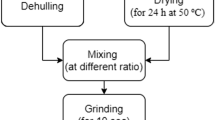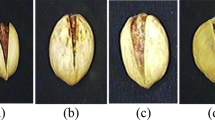Abstract
The safety and quality of the food are considered an essential issue in the entire world. This is due to food being the basis of human health. Nowadays, machine learning algorithms have embodied the recent technology in all stages of food processing such as food grading, food quality determination, and food classification. Pistachio nuts have an important role in the agricultural economy. To increase the efficiency of post-harvest industrial processes, there is a need to introduce technologies for classifying different species of pistachio. This study considers an automated model to separate pistachio species. The proposed pistachio species classification consists of three main phases; features selection based on slime mould algorithm phase, feature interpretation based on explainable artificial intelligence phase, and finally classification of pistachio species using logistic regression phase. The proposed pistachio species classification model obtained overall 90% classification accuracy, 90% precision, and 91% f1-score.
Access this chapter
Tax calculation will be finalised at checkout
Purchases are for personal use only
Similar content being viewed by others
References
O. Bazrafshan, M. Ehteram, S. Dashti, Y. Feng, F. Yenn, A. Najah et al., Predicting crop yields using a new robust Bayesian averaging model based on multiple hybrid ANFIS and MLP models. Ain Shams Eng. J. 13(5), 101724 (2022). https://doi.org/10.1016/j.asej.2022.101724
A. Heidary-Sharifabad, M. Zarchi, S. Emadi, G. Zarei, An efficient deep learning model for cultivar identification of a pistachio tree. Br. Food J. 123(11), 3592–3609 (2021). http://doi.org/10.1108/BFJ-12-2020-1100
M. Koklu, Pistachio dataset (n,d.). https://www.muratkoklu.com/datasets/
S. Li, H. Chen, M. Wang, A. Heidari, S. Mirjalili, Slime mould algorithm: a new method for stochastic optimization. Future Gener. Comput. Syst. S0167739X19320941 (2020). http://doi.org/10.1016/j.future.2020.03.055
N. Mavani, J. Ali, S. Othman, Application of artificial intelligence in food industry-a guideline. Food Eng. Rev. 14, 134–175 (2022)
S. Nosratabadi, S. Ardabili, Z. Lakner, C. Mako, A. Mosav, Prediction of food production using machine learning algorithms of multilayer perceptron and ANFIS. Agriculture 11(5) 1–28 (2021). https://www.mdpi.com/2077-0472/11/5/408
I. Ozkan, M. Koklu, R. Saracoglu, Classification of pistachio species using improved K-NN classifier. Prog. Nutr. 23(2) 1–9 (2021). http://doi.org/10.23751/pn.v23i2.9686
M. Ribeiro, S. Singh, C. Guestrin, “Why should I trust you?”: explaining the predictions of any classifier, in Proceedings of the 22nd ACM SIGKDD International Conference on Knowledge Discovery and Data Mining (2016), pp. 97–101. https://doi.org/10.18653/v1/N16-3020
G. Sayed, A. Darwish, A. Hassanien, Binary whale optimization algorithm and binary moth flame optimization with clustering algorithms for clinical breast cancer diagnoses. J. Classif. 37, 66–96 (2019). http://doi.org/10.1007/s00357-018-9297-3
G. Sayed, G. Khoriba, M. Haggag, A novel chaotic equilibrium optimizer algorithm with s-shaped and v-shaped transfer functions for feature selection. J. Ambient Intell. Hum. Comput. 1–26 (2022). https://doi.org/10.1007/s12652-021-03151-7
P. Tsakanikas, A. Karnavas, E. Panagou, A machine learning workflow for raw food spectroscopic classification in a future industry. Sci. Rep. 10, 1–11 (2020)
Y. Zhang, Y. Weng, J. Lund, Applications of explainable artificial intelligence in diagnosis and surgery. Diagnostics 12, 1–18 (2022). https://doi.org/10.3390/diagnostics12020237
L. Zhu, P. Spachos, E. Pensini, K. Plataniotis, Deep learning and machine vision for food processing: a survey. Curr. Res. Food Sci. 4 233–249 (2021). http://doi.org/10.1016/j.crfs.2021.03.009
Author information
Authors and Affiliations
Corresponding author
Editor information
Editors and Affiliations
Rights and permissions
Copyright information
© 2023 The Author(s), under exclusive license to Springer Nature Switzerland AG
About this chapter
Cite this chapter
Sayed, G.I., Hassanien, A.E. (2023). Explainable AI and Slime Mould Algorithm for Classification of Pistachio Species. In: Hassanien, A.E., Soliman, M. (eds) Artificial Intelligence: A Real Opportunity in the Food Industry. Studies in Computational Intelligence, vol 1000. Springer, Cham. https://doi.org/10.1007/978-3-031-13702-0_3
Download citation
DOI: https://doi.org/10.1007/978-3-031-13702-0_3
Published:
Publisher Name: Springer, Cham
Print ISBN: 978-3-031-13701-3
Online ISBN: 978-3-031-13702-0
eBook Packages: Intelligent Technologies and RoboticsIntelligent Technologies and Robotics (R0)




